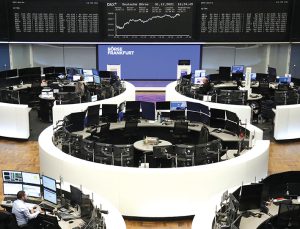BLOOMBERG
European stocks retreated after a fresh set of downbeat economic data from the euro area and China, while the single currency sank to a nearly three-month low against the dollar. The Stoxx 600 dropped as much as 0.8%, edging lower for the fifth day, while US equity futures also retreated. The dollar strengthened as much as 0.5% against its Group-of-10 peers, touching the highest level since March. Yields on US Treasuries climbed following a US holiday on Monday.
China’s services sector saw the slowest growth this year in August, an industry survey showed, adding to evidence the economic recovery is losing traction and damping earlier optimism over government stimulus. In Europe, the composite purchasing managers’ index undershot expectations, posting a contraction for a third straight month.
“There is real concern for the euro-area picture, with survey data suggesting the economy is sliding into recession,” said Sarah Hewin, head of Europe and Americas research at Standard Chartered. “It raises questions over how aggressive the ECB can be going forward.”
The European Central Bank holds its interest-rate meeting next week. The disappointing Chinese PMI figures weighed heavily on European stock sectors exposed to the world’s No 2 economy, with luxury and consumer names such as LVMH and Kering as well as sportswear maker Adidas losing more than 2%.
The data curbed the positive sentiment generated by news of bumper new-home sales on the weekend in two major Chinese cities that appeared to hint authorities’ stimulus steps were taking effect. Earlier in the day, the MSCI Asia Pacific Index headed for its first drop in seven days and the offshore traded yuan slid.
In a rare spot of good news, Country Garden Holdings Co said it paid coupons on two dollar bonds within their grace periods. The troubled developer that has come to symbolise China’s property woes is said to be proposing to extend principal payments for eight yuan bonds. Standard Chartered’s Hewin expects more measures from Beijing to boost credit growth. “There has been a huge number of supportive measures and our view is there is scope on the fiscal side and room for more rate cuts,” she added.
The Chinese data also hit the Australian dollar, which fell as much as 0.7% against the greenback. Already the worst-performing developed market currency this quarter, the Aussie was also undermined by signs the central bank won’t tighten rates further. The bank stood pat on Tuesday as expected.
The US dollar benefited from the woes elsewhere. While many economists say the Federal Reserve has come to the end of its 18-month long policy-tightening campaign, a relatively robust economy means interest-rate cuts may not come any time soon.
Goldman Sachs Group sees just a 15% probability of a US recession in the coming year, down five percentage points from their previous estimate.
“The disappointing PMI data out in China and Europe so far have dragged the market to backing the dollar,” said Roberto Cobo Garcia, head of G10 FX strategy at Banco Bilbao Vizcaya Argentaria SA. Elsewhere, Brent crude slipped for the first day in six, trading down 0.9% at $88.22 per barrel and moving away from the nine-month highs hit recently on expectations of further supply cuts from the Opec+ producers’ group.
 The Gulf Time Newspaper One of the finest business newspapers in the UAE brought to you by our professional writers and editors.
The Gulf Time Newspaper One of the finest business newspapers in the UAE brought to you by our professional writers and editors.
